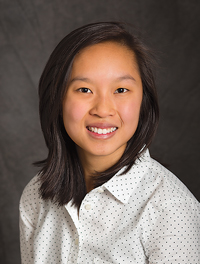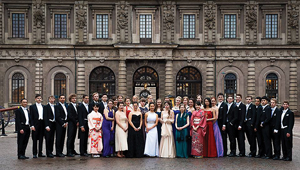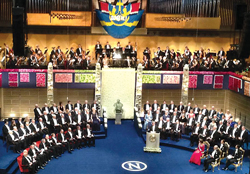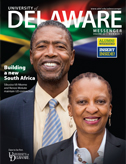Adventurous first year for accomplished student

Hannah Wastyk, AS17, a Eugene du Pont Memorial Distinguished Scholar in the UD Honors Program, has had an eventful year. An asteroid was named after her, and she traveled by invitation to Sweden in December to attend the Nobel Prize ceremonies—both the result of her high school success at the Intel International Science and Engineering Fair. Working in a research lab at Penn State University, Wastyk was able to show through inhibition of a gene associated with melanoma that she could stop cancer cell growth in multiple cell lines and in mouse models.
Here is her account of her experience.
ON THE GREEN | The second I heard my name boom across the crackle of the microphone, the feeling of sheer elation washed over me, as I was overcome with emotion for the first time in my life.

The Intel International Science and Engineering Fair is the largest precollege science fair in the world, attracting over 1,600 young scientists from 70 different countries every year. Being the first from my school to ever compete in a science fair, the honor of taking home “Best in Category” and “First Place in Cellular and Molecular Biology” was something beyond my wildest dreams. When my name was called again for a Grand Award of attendance at the 2013 Nobel Prize Ceremony in Stockholm, Sweden, I knew the adventure had just begun.
About 20 students from across the globe, each representing various organizations and competitions, congregated in a small hostel in Stockholm for the trip of a lifetime. During the beginning of the week, we presented our own research to Swedish students and networked with companies abroad. Later that week, the Laureates presented their work to the press, and we were able to sit in and ask questions. During the United States Ambassador Reception and Nobel Reception, we talked to the Laureates one on one and discussed the future of their research.

A definite highlight of the week was getting to talk to a Nobel Laureate in Medicine, Dr. James Rothman. I asked him about his research in vesicle transportation and its future in cancer treatment. Instead of answering my question directly, he asked me what I thought about it. We were able to discuss my research briefly, while I shared my opinion, and he told me his predictions for the future of cancer research.
The most exciting day of the trip was filled with the Nobel ceremony, the Nobel banquet and the Nobel Nightcap after-party. The Nobel ceremony was the most majestic display of intellect and prestige that I have ever experienced, as I was able to watch each Laureate receive the medal from the king of Sweden and bow to the audience. The banquet took place in Stockholm City Hall, and was filled with opera performances between each course and dinner served on golden plates. After the banquet, the night had just begun, as the Nobel Nightcap went from 11 p.m. to 5 a.m. the next morning. The Nobel Nightcap is known as “The Grandest Party” of the year, and after attending, I agree with this sentiment wholeheartedly.
Overall, my experience at the 2013 Nobel Prize ceremony was more than I could have ever dreamed of. Seeing a fiery passion to change the world, to pioneer a path unseen, to touch the lives of others on a global scale, was something I saw in the Nobel Laureates and scientific peers alike. After this experience, I knew research was a mindset that I began to call home.






